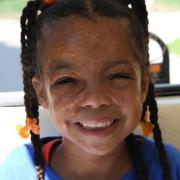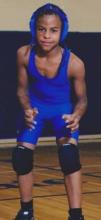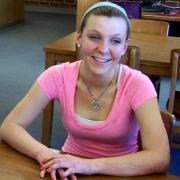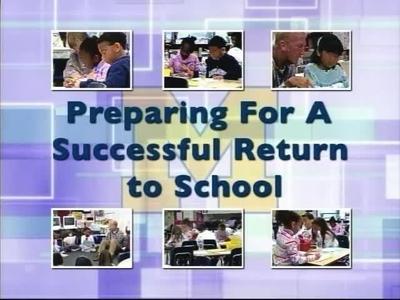Stories
Sumya
Not Just Another Ordinary Day
Crystal, Sumya's mother:

Approximately ten minutes later, my older child attempted to climb over the gate, and at that moment it gave way. My three year old daughter Sumya who was behind her at the time, fell over her and into the kitchen. The impact knocked over the frying pan, I could see that some of the grease had spilled onto Sumya’s face and the top of her left arm. Even though I took the proper precautions to have the safety gate placed in the kitchen area, the pan was on the front burner with the handle out, causing it to tip over.
I immediately rinsed the areas off in cool water and rushed to take her to the hospital which was only a few blocks away. While in the emergency room, my husband and I were informed that because my daughter’s burns were to her face they were going to have to transfer her to a burn center. I remember thinking that this must be really serious if they needed to send her there.
When we arrived at the burn center I could not believe how much swelling there was just from the short time we last saw her at the other hospital. The doctors told us she had a 9 percent scald burn from the grease and that her right eye lid, which was now swollen shut, may need to have a skin graft.
It was hard having to spend so much time at the hospital away from our other children, but fortunately my parents were there to help. My employer was also very understanding and supportive during this time. The hospital staff was great and provided our family with informative burn prevention and safety education materials to keep our family safe. The REACH Program Staff also spoke to us and Sumya’s teachers about her return to school. It helped us so much to know we had this support.
Sumya’s recovery went well and in the end she did not have to have skin grafting done. After 17 days in the hospital, Sumya was able to come home.
The following December, we were invited back for the burn center's holiday party. It was great to visit the staff and show them how well Sumya has recovered.
Erica, Sumya’s preschool teacher:
After we were notified by Sumya’s mother about her injury, Sumya’s other teacher and I decided we would visit her. Visting Sumya and meeting with the hospital staff and her parents gave us a better understanding of how to best meet her needs and begin to prepare for her return to school.
Sumya transitioned so well back into our room, and after one round of questions from the students, (which Sumya answered very matter of fact) our school day went completely back to normal.
Staff from the REACH Program came to the school after her return to discuss and address any concerns that Sumya, her classmates, or teachers might have after her intital return.
Things to consider:
- Parents can feel guilty even though they have taken steps to avoid injury
- Participating in prevention education can help people cope with guilt and anxiety
- Kids and teachers of all ages benefit from school re-entry education
- Burns to the face change over time with healing
- Consider sharing relevant information regarding the student’s condition with other school personnel the student may come into contact with. This may include bus drivers, cafeteria staff, coaches, and custodial staff.
Marty
From Tragedy to Triumph
Shannon, Marty's mother:

I was unaware that my two sons had ventured into the utility area of my home. I remember hearing a commotion and ran toward the room. All I could see were flames. My son Eladio came running out of the room with the bottom of his pant legs on fire. I grabbed him and was able to quickly put out the small flames, and thankfully he was not injured. Marty, his brother, then came running out with his clothes on fire. I remember screaming and my mother, who was visiting, ran to help. She grabbed a sheet and wrapped Marty in it. I ran to call 911.
The emergency responders arrived and ran out of the house so fast with Marty, I didn’t even know how badly he was hurt. They air lifted him to the burn center. Marty, just two years old at the time, had severe burns to 65 percent of his body.
The next time I saw Marty he was all wrapped in gauze and hooked up to machines, all I could see was his eyes. I was so terrified that my baby was going to die. I remember that I did not sleep for the first three nights, I just walked the floor. There were so many days when I thought I was going to break down, but I knew that I couldn’t, I had to stay strong for Marty. It took one of the nurses to reassure me that I didn’t have to cry anymore, to know that he was going to be ok.
If it wasn’t for my mother and all the support I received from the hospital, I don’t know how I would have gotten through this. I consider the burn center staff second family. Marty spent 80 days in the hospital, 29 days in the intensive care unit and 51 days in the rehabilitation unit.
Marty is fortunate to have the support of his family. His brothers, sisters, and grandmother have always been very supportive of him. Together, we have raised him to be strong and secure. Each year Marty attends burn camp through the hospital. Marty is always willing to share his experience with others who may be wondering about his scars.
When it was time for Marty to start kindergarten, I worried if the other kids would tease him and I just wanted to keep him home with me. I remember crying about it and Marty told me, “Mommy you don’t have to cry, it doesn’t bother me,” and at that moment I knew he was going to be ok. As Marty started middle school, he needed additional surgeries related to his injuries. This caused extended absences from school, and he was not able to participate in after school activities or sports. Also at this time, our family had to move, which further complicated the situation, and meant he would be starting a new school.
To make this adjustment easier for him, the REACH Program staff met with Marty and I, along with his new school principal, and primary teacher. Marty’s on-going medical care, desire to participate in sports, and adjustment to a new school environment was outlined and addressed.
Things to consider:
- A burn injury is life changing
- Parents fear for their child’s survival and recovery
- A child may require surgeries over time
- Reconstructive surgeries can cause absences from school
- Absences from school interfere with lessons and sports
- Kids are willing to talk with others about their burn injury experience
Perri
Our Hero and Pillar of Strength

They say your life flashes before you in time of tragedy, but I say your life as you know it can be turn upside down in an instant.
It was late May 2001, my five year old son Mitchell, and my three year old daughter Perri, were outside playing in the yard. We had just gotten back from getting my son’s baseball pictures taken. The phone rang, it was my grandmother, a few minutes into the call I heard a loud explosion and black smoke rolled into the kitchen from the porch. I dropped the phone and ran through the smoke looking for my children. I saw Perri engulfed in flames; an image that is forever in my mind.
My son was not injured in the gasoline explosion, but he, my husband, and I carry the emotional scars from that day. The family we once were, carefree and close, has now forever changed.
I picked her up and ran into the house while trying to extinguish the flames. I tore all of her clothes off and put her in the shower telling my son to call 911. My thoughts at the time were, “I’ve got to stay focused, and I have to stay strong in order for my baby to live."
We finally get to the hospital, but I was not able to see her, I remember screaming over and over, “this is not happening, please call my husband, please let me see my daughter!” Finally a nurse came and told me that she needed to be flown to a regional burn center.
Forty minutes later, we saw the air medical flight crew wheeling her to the helicopter. We ran to her; the flight nurse said, “she is in good hands, you can give her a kiss and tell her you love her.” We all did, hoping this would not be the last time we would see her.
We arrived at the burn center. There was a lot of commotion, people coming and going. The doctors came out and told us that she was on life support and that she had burns covering 38 percent of her body. The good news was that she did not have an inhalation injury, a small reprieve from all of the bad news we were receiving.
We finally were able to see her, she did not look like my little girl at all.There were so many machines hooked up to her and she was all wrapped up in gauze. A part of me died that day, I would have given any thing if it could have been me lying there instead of my daughter.
The staff was wonderful and caring, they were comforting in a time of despair. The bond we formed with the staff we still have to this day. They are family to us not just her caregivers. I knew she was in the best hands and that she would prevail.
After a month in the hospital she was finally released, it was like a gift from heaven. Although she could not walk and had a long road ahead of her, at least she was alive, and I could still hold her and tell her I love her unconditionally.
Perri has become a very voicterous and strong willed person, her burns do not define her, she defines them. She is my hero and a pillar of strength.
Scott, Perri's father:
I remember getting that call at work, and hearing that my daughter had been badly injured. I just wanted to be there with her, so I rushed to the hospital not knowing what to expect. When I arrived at the hospital, I saw a minister coming out of her room. I remember dropping to my knees and saying “please God don’t let her die, don’t let her die,” that was the worst moment of my life. I thought I had lost my daughter.
The days ahead were filled with many ups and downs. Many hours were spent in the waiting room with other families who were also coping with an injured family member. The bond that was formed with these families and the medical staff, as well as the support from our family and friends was what pulled us through this difficult period. Unless you have been through a tragedy like this, you just don’t understand how difficult it can be.
Mitchell, Perri's brother:
As a sibling of a burn survivor, I’ve experienced many changes to friends, family, and to myself. At times, it was very stressful and it felt like no one cared about me anymore. But it was only really difficult when I was younger in grade and middle school, when kids picked on me. Now I realize how important my family really is, and how many caring people there are that can make a difference.
Hello, I am Perri, I’m fourteen years old and I am a burn survivor.
I felt I wasn’t the only one that got hurt from the accident. My mom, dad, and brother suffered emotionally.
What has been difficult for me is being teased by school and neighborhood kids. Those kids couldn’t imagine what I went through and even though they treated me like that, I still wouldn’t want them to go through what I did. It made me feel better to think on the bright side of things, like if I wasn’t burned, I wouldn’t have met all of the nice people at the hospital. The burn center staff helped me through it all and I love them like my family. I am thankful that they helped me. They showed me hope and that I am special. Even though I am burned, I am loved by many people.
Going to burn camp has helped me realize that other kids have been burned like me. I feel more confident in myself now. I still get surgeries and now have had 37. But I am cool about it now.
So don’t feel bad and sorry for yourself even though things look dismal because there is always light at the end of the tunnel and there’s always hope, no matter what you go through. It might be a rough road but you’ll make it through just like I did. I know you can so keep trying and feel good about yourself because you are just like me….one of a kind.
Love ♥ Perri
Things to consider:
- A serious burn injury impacts all family members
- Staff support is very meaningful to patients and families
- Injury brings changes
- A burn injury can cause emotional as well as physical scars
- Kids at school and in the neighborhood can tease and bully
- Learning about school and community re-integration can help anticipate and address these challenges
Amy
Proof that miracles do happen

Amy’s injuries required her to undergo many skin grafting procedures. Due to the severity of the burn injury to her right leg, an amputation of her lower leg was necessary. Amy’s family faced many challenges after the accident, including mourning the loss of family, coping with Amy’s injuries, and a language barrier. Amy’s mother was fluent in Spanish and spoke little English. During Amy’s treatment, a translator was provided to help the family communicate with the hospital staff.
As Amy recovered, she was fitted for a prosthetic leg, and special garments that she would have to wear. After spending three months in the intensive care unit and an additional three months in the rehabilitation unit, Amy was able to go home. This was a milestone in Amy’s recovery and a joyous time for her family.
After her release from the hospital, Amy and her family still had many challenges ahead, including dealing with the physical pain and limitations of her injuries, as well as the emotional impact of their family tragedy.
As the time approached for Amy to begin school, her mother worried about the many challenges Amy would face. Her fears would soon be eased as Amy was embraced by her elementary school’s teachers and classmates.
As Amy began the 3rd grade, she fell and broke her leg, confining her to a wheelchair. This new injury and ongoing burn reconstruction surgeries caused Amy to miss many days of school. The REACH Program helped address these new challenges that Amy was now facing. Special transportation was provided since she could no longer take the bus. Additional tutoring helped her maintain her school assignments. The REACH Program enacted a successful, comprehensive, and in-depth intervention that supportively re-directed a struggling girl, providing critical help at a very vulnerable juncture of her life.
In June 2010, Amy attended a burn survivor camp for children for the first time. This proved to be a turning point for Amy, when given the opportunity to experience the activities offered, she was given the chance to thrive. When asking Amy what she would want her teacher and other kids at school to know about her she stated, “I want to take the pictures of camp to school to show them all the things I did at camp. I want them to know that I can do anything that other kids can do.”
When Amy entered the fifth grade, she transitioned from elementary to middle school. To ease the fear of a new school environment, REACH program staff developed a plan for Amy to have a successful transition. A meeting with Amy’s mother, former teacher, new teacher, school principal, and REACH Program staff was scheduled. This collaboration addressed concerns surrounding Amy’s education, medical needs, and overall well-being. Amy was asked to write a letter introducing herself and what she wished others to know about her burn injury. This letter was distributed to students and parents in an orientation packet given before the start of the school year. To read Amy’s letter click here.
Things to consider:
- Primary language and culture can impact burn care and education
- Some kids have to deal with amputation (loss of a body part) as a part of their injury
- Schools can assist with special needs such as transportation and tutoring
- Camp helps kids have a range of experiences that help them feel good about themselves
- Kids can benefit from extra help during periods of transition/change


